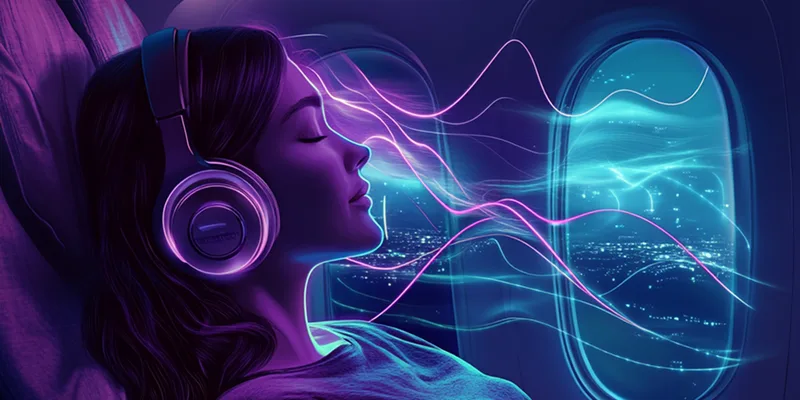For centuries, humans have recognized the healing power of sound. From ancient Tibetan singing bowls to modern binaural beats, sound therapy has been used to promote relaxation, reduce pain, and enhance wellbeing. Now, cutting-edge research is revealing how specific audio frequencies can provide almost instantaneous relief from motion sickness—a breakthrough that's revolutionizing how we approach travel comfort.
The science behind sound therapy for motion sickness lies in understanding how our inner ear, brain, and nervous system interact. When these systems are properly aligned through targeted audio frequencies, nausea and dizziness can be eliminated in as little as 30-60 seconds.
The Science Behind Sound Therapy
Sound therapy for motion sickness isn't just wishful thinking—it's grounded in solid neuroscience research. The breakthrough came from understanding how specific sound frequencies can directly influence our vestibular system, the complex network in our inner ear responsible for balance and spatial orientation.
How Sound Affects the Inner Ear
Direct Vestibular Stimulation
Low-frequency sounds (particularly around 100 Hz) can penetrate bone and directly stimulate the otolith organs in your inner ear, helping to stabilize your sense of balance.
Neural Pathway Reset
The sound therapy helps "reset" the confused neural pathways that cause motion sickness, providing your brain with clearer signals about your body's position and movement.
Rapid Response Time
Unlike medications that can take 30-60 minutes to work, sound therapy can provide relief in as little as 60-90 seconds, making it ideal for sudden onset symptoms.
The 2025 Breakthrough Study
A groundbreaking study published in 2025 from Nagoya University provided compelling evidence for sound therapy's effectiveness. Researchers tested 100 Hz sound stimulation on both animal models and human subjects, discovering remarkable results that have revolutionized our understanding of motion sickness treatment.
Study Results
- 73% reduction in nausea symptoms
- 60-second treatment duration
- No reported side effects
- Effective across age groups
Key Findings
Frequency Matters: 100 Hz proved most effective for vestibular stimulation
Volume Control: 80-85 decibels provided optimal results without discomfort
Timing is Key: Pre-treatment before motion exposure showed best prevention results
Universal Application: Effective for car, plane, and boat motion sickness
Real-World Applications
The beauty of sound therapy lies in its practical applications. Unlike traditional remedies that require advance planning or have significant side effects, sound therapy can be deployed instantly whenever motion sickness symptoms arise or as a preventive measure before travel.
Travel Scenarios
Car Journeys
Perfect for passengers who can't look out the window or need quick relief during winding roads.
Air Travel
Ideal for takeoff, landing, and turbulence when traditional remedies aren't practical.
Sea Voyages
Particularly effective for cruise passengers and boat trips where weather conditions create unexpected motion.
Amusement Parks
Great for quick relief between rides or before attempting particularly challenging attractions.
Why Traditional Remedies Fall Short
While medications like Dramamine or natural remedies like ginger can be effective, they often come with limitations that sound therapy elegantly sidesteps.
Traditional vs. Sound Therapy:
| Factor | Traditional Meds | Sound Therapy |
|---|---|---|
| Speed of Relief | 30-60 minutes | 30-60 seconds |
| Side Effects | Drowsiness, dry mouth | None reported |
| Convenience | Must plan ahead | Use as needed |
| Cost | Ongoing expense | One-time purchase |
The Future of Motion Sickness Treatment
Sound therapy represents just the beginning of a new era in motion sickness treatment. As our understanding of neuroscience and audio technology advances, we can expect even more sophisticated and effective solutions.
Emerging Technologies
Personalized Frequency Profiles
AI-driven systems that adapt to individual vestibular responses for optimized relief.
Real-Time Motion Adaptation
Smart audio systems that adjust frequencies based on current motion patterns and intensity.
Predictive Prevention
Wearable devices that detect early motion sickness signs and automatically trigger relief protocols.
Experience the Science Yourself
The best way to understand how sound therapy soothes nausea is to experience it firsthand. Dizzout's carefully engineered audio sequences represent years of research condensed into an easy-to-use application that puts the power of sound healing in your pocket.
Whether you're a skeptic curious about the science or someone desperate for motion sickness relief, Dizzout offers a risk-free way to discover how the ancient art of sound healing has been perfected for modern travelers.
